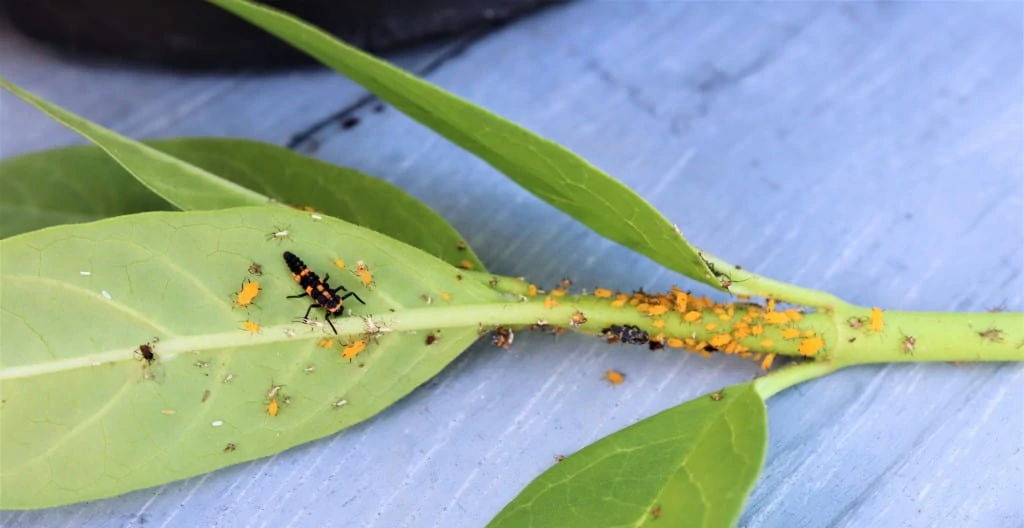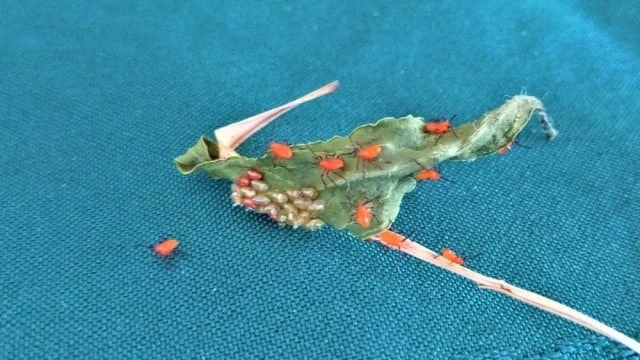by Amanda Rose Newton
Most of us have planted a milkweed or two in our yards (or container gardens) with the hopes of attracting the beautiful Monarch Butterfly. In addition to the visiting hungry caterpillars and nectar feeding adults, a plethora of additional insects can be found lurking behind the leaves.

Milkweed: Toxic Wasteland or Valuable Real estate?
Milkweed, (Asclepias spp.) gets its common name for the milky, sticky, white sap it produces when leaves and floral parts are plucked from the stem. This adaptation is what has allowed the genus to be successful over the entire span of North America and contribute over 70 species to our landscape.
Twenty-one species of milkweed are native to Florida, with several of the native species available for sale at Rockledge Gardens.
This toxicity has not slowed down insects who, always the entrepreneurs, saw this as an opportunity to enjoy less competition for resources.
Milkweed Residents
As you may have guessed, all dwellers of the milkweed have figured out how to get around the whole poisonous issue to lead full, healthy lives. Each has its own way of managing the toxins, all fascinating, and makes the dynamics going on in your butterfly garden even more exciting!
Butterflies and Moths
We are all familiar with the Monarch, but did you know there are other caterpillars who chose the milkweed as a host?
The beautiful Tussock and Cyncia moths feast on milkweed as fuzzy caterpillars, too! (Fun Fact: If a caterpillar is fuzzy, it is probably a moth)
Like the monarch, they feature orange coloration, resembling a tight orange and black sweater on their abdomens. The use of orange is a trick used all over the animal world known as aposematic coloration, as it screams “don’t eat me”. Many predators, such as birds, who rely on color, have made the mistake enough to realize creatures that eat milkweed all day end up with those toxins and will leave them untouched.
Smart! So how do they pull this off? The monarch and milkweed eating moths can sequester those cardenolides (the toxic chemicals in the plant) and store them in their bodies as caterpillars. These chemicals stay present through metamorphosis, and as adult butterflies, they are now armed with an acquired defense. If you haven’t thought of a great Halloween costume yet, a monarch would be the perfect choice for a COVID-ready social distancing appropriate look!
Milkweed Aphids
Aphids are no gardener’s favorite and the little orange guys are usually one of the first insects to show up on newly purchased milkweed plants. Most of us are used to the green aphids that can be found on numerous plants throughout the yard, but with over 4000 (yes, FOUR THOUSAND) species worldwide, some are thankfully a bit more specific.
The milkweed aphid happily stays put on milkweed plants, because like its more tolerable butterfly neighbors, it can also sequester the toxins to use as a defense. Luckily, ladybugs do not seem to mind the toxins in small doses, and will happily take care of excess aphids on milkweed plants.
Milkweed Bugs (small and large)

Second only to aphids in numbers and annoyance factor, the milkweed bugs also reside on milkweed most of the year.
Since they do not go through a complete metamorphosis like the butterflies and moths, the younger versions (all 5 stages of them) are easily mistaken for completely different insects.
The adults are easy to spot as they will have wings, the younger juveniles are often brighter orange and lack the power of flight (just like American teenagers and driver’s licenses). The small milkweed bug (Lygaeus kalmii) differs from the large (Onocopeltus fasciatus) by size and black head. They can overpower other insects on the plant, so keeping their population in check is advised.
Milkweed Beetle
While not as common in Florida, occasionally, the swamp milkweed leaf beetle (Labidomera clivicollis) rents out a room or two at the milkweed villa. Our native swamp milkweed, as one might have guessed, is the crowd favorite. Leaf beetles are prolific feeders and will readily out-compete caterpillars but can easily be controlled by handpicking them off and tossing in soapy water. Unlike the rest of the crew, milkweed beetles do not sequester toxins into adulthood, proving orange and black is just a really great look.
Controlling Milkweed Pests
Most of the insects can be left alone to do their thing without fear of consuming everything in your garden. However, many can outcompete caterpillars who need a little extra help in the population department these days.
To avoid using pesticides (it’s a good sign if you have pests on your milkweed– it means your plants are pesticide-free), hand picking and tossing pests into a bucket of soapy water is your best bet. Another solution?
Plant A LOT of milkweed! With so many interesting native varieties, you can add to the biodiversity of your yard and help out our local monarch population.
Choose Native Over Tropical Milkweed
While tropical milkweed (Asclepias curassavica) is easier to find at most nurseries, it is not the ideal plant for attracting monarchs. Native to Mexico, it stays in bloom longer than our natives which die back naturally in the winter months.
After many years of studying milkweed ecosystem dynamics, scientists believe the longer living tropical milkweed is causing the monarchs to not complete their journey to Mexico and stick around here.
More concerning is the parasite, Ophryocystis elekroscirrha (OE), that has been problematic to Monarch health for decades is likely to persist in the environment longer when tropical milkweed is not cut back annually.
This gives more opportunity for butterflies to contract OE causing further decline in numbers.
Already have tropical milkweed planted? No worries! Simply mimic nature and cut back your milkweed starting in November and it will still come back next year. If you do have the choice, support your local Florida growers and choose native!


